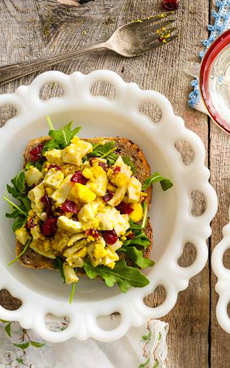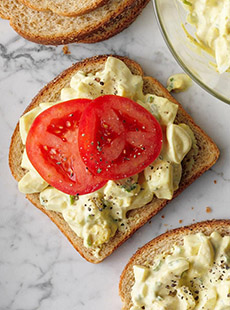Curried Egg Salad Recipe For National Egg Salad Week
 [1] Curried egg salad on toast (photo © Louise Mellor | Safe Eggs).
|
To mark the end of National Egg Salad Week, we made a delicious curried egg salad recipe.
And we did it the easy way, purchasing pre-cooked and peeled hard boiled eggs from Trader Joe’s. While we were at it, we picked up some pre-grilled chicken breasts across the aisle, and made a batch of curried chicken salad as well. We did some blending, and decided that we preferred egg salad and chicken salad separately, rather than combined. A different on a traditional favorite, this curried egg salad is fresh and invigorating. The recipe is by Louise Mellor for SafeEggs.com. Find more delicious egg recipes at SafeEggs.com. National Egg Salad week begins the day after Easter, a logical time to begin using up all those colored eggs! > The history of curry powder. > The different types of eggs: a photo glossary. > The year’s 27+ sandwich holidays. > The year’s 40+ salad holidays. > Below: myths about using eggs. Ingredients For 4 Servings 1. CUT hard boiled eggs into small dice. 2. COMBINE the eggs with the remaining ingredients in a small bowl and stir well to combine. 3. FOLD in the arugula and serve the salad atop the bread, green salad, or with crackers. |
|
|
EGG MYTHS Davidson’s Safest Eggs are whole raw eggs that have been pasteurized in the shell, using special equipment. Pasteurization kills the salmonella, as does cooking unpasteurized eggs. We go out of our way to find Davidson’s Safest Eggs when we’re making Caesar salad, mousse, steak tartare and other recipes that require raw eggs that are not cooked—not to mention making raw cake batter and cookie dough safe enough to enjoy. Many people believe different myths about egg safety. Here, Davidson’s puts them to rest: |
 [4] All peeled and ready to eat. Photo by Elvira Kalviste | THE NIBBLE. |
|
|
CHECK OUT WHAT’S HAPPENING ON OUR HOME PAGE, THENIBBLE.COM. |
||




